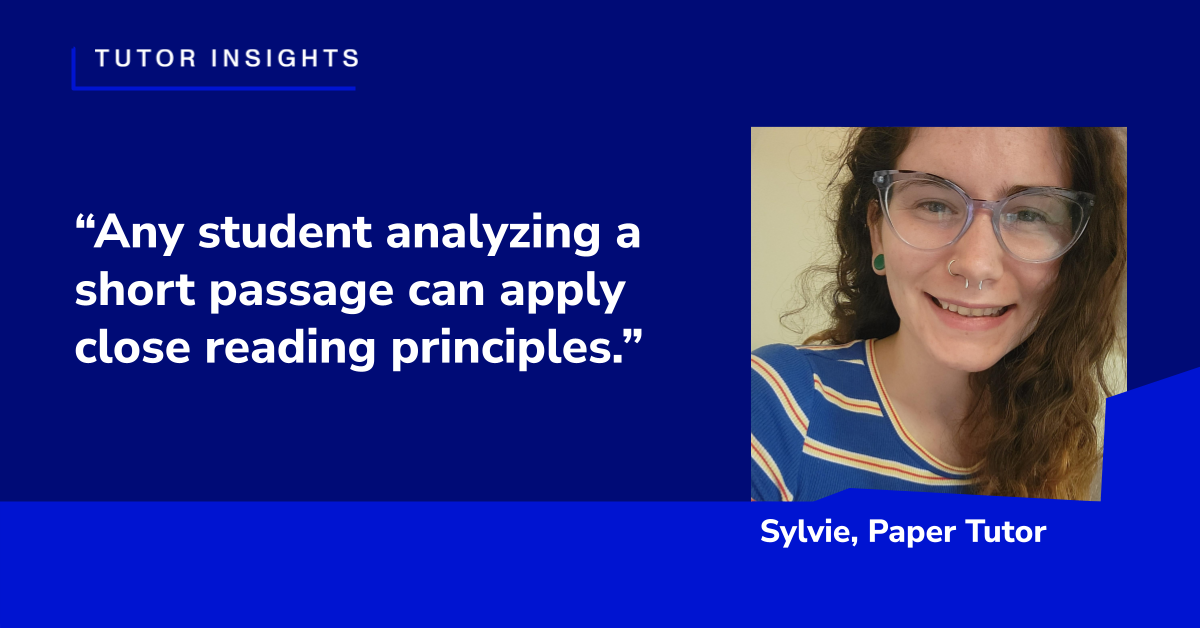
How one Paper tutor coaches students through the 'close read'
Are your students struggling to extract understanding and insights, both large and small, as they pore over literary passages? Sylvie, a tutor at Paper, shares a few tried-and-tested strategies for mastering these texts.
When students’ literary analyses could use a hand
As both an essay reviewer and an English tutor, I’ve noticed that many students struggle with literary analysis, whether they’re working on building nonfiction reading comprehension or diving into novels, short stories, poems, and other texts. For instance, I often find myself encouraging students to provide more than just a quick explanation of the evidence they’ve shared and to dive just a bit more deeply into their commentary.
This thorough work marks the difference between having students passively analyze sentences and allowing them to truly delve into the piece, connecting their analyses to the passage as a whole. It’s what separates surface-level insights from deeper understanding.
5 key elements students should remember during their close reading
As an English tutor, my personal preference when analyzing literature is to engage in something called “close reading” with short passages. With a close read, I can more easily notice specific details—like punctuation use, verb tense, sensory details, sentence length, and literary devices—over more abstract pieces of a literary work, such as the theme, characterization, plot, setting, and so on. Obviously, these elements are important too, but close reading can provide students with a useful entryway into understanding the text.
Rest assured that close reading isn’t just a tool for literary experts, though. In fact, any student analyzing a short passage can apply close reading principles during their own review to get a more in-depth understanding of the text.
With that in mind, there are a few different ways tutors and teachers can engage students by having them analyze literary pieces from a more detailed point of view. Here are some of the most important elements to consider during a close read.
1. Punctuation
Students can start by pointing out artistic punctuation use. This might include periods, ellipses, commas, exclamation points, question marks, semicolons, colons, parentheses, slashes, em dashes, and any other pieces of punctuation the author may have used to get a point or mood across.
I encourage students to try reading the passage out loud to see how it sounds and how the punctuation marks affect the way the passage is read and understood. How might the meaning of the passage change if we replaced an exclamation point with a period, for example? Why does that exclamation point matter?
2. Verb tense
Readers will interpret a text differently depending on whether the author wrote it in the past, present, or future tense. Try asking your students how the story might change if the verb tense were to shift. See if they can better pick up on why verb tense matters and what effects it has on the story as it stands.
3. Sensory details
When an author suddenly uses descriptive sensory details—sight, touch, sound, smell, or taste—they’re doing so on purpose. Asking the student why an author might choose a particular moment to engage the reader’s senses can help them think about the meaning of that particular moment in the text.
4. Sentence length
When an author abruptly varies their sentence length from short to long or vice versa, it has an effect on the way we read and understand those sentences.
On the other hand, if an author chooses to write a sentence that’s one paragraph long, that also tells us something about the author’s writing style and how the text can be interpreted. What are the benefits or consequences of these out-of-the-ordinary sentence lengths? What meaning or feeling do they impart?
5. Literary devices
Lastly, literary devices can create layered meanings in a text by strengthening the mood, rhythm, tone, voice, and so on.
Asking students to name the literary devices they know—think metaphors, allegories, foreshadowing, irony, repetition, and more—can jump-start conversations about what an author’s goal or intent is at a particular moment in the text.
Give students the gift of literary understanding
Part of what makes these close reading principles so valuable is that they can help students more easily focus on the task at hand. They don’t need to work with an entire book. Rather, asking students to choose a favorite or confusing chapter, scene, paragraph, or even sentence can help them feel like their homework is a little less overwhelming. It can be valuable to start analyzing a scene the student feels invested in or, on the other hand, to analyze a scene that left them feeling uncertain.
Although this close reading method may not work for all students, it remains a useful skill to learn because it helps develop a deeper understanding of the English language: its rhythm, its grammar, and its syntax. In turn, students can further explore the varying stylistic choices they might make in their own writing or apply something new to a draft.
One of the benefits of having their essays reviewed is that students will be able to try out these new techniques in their own assignments. All in all, close reading helps learners become stronger writers. As they practice this strategy, they’ll be sure to glean much, much more from texts in the future.
Looking for more tools to enhance your students’ English skills? Learn more about how Paper’s Essay Review helps real students level up their essay-writing skills.

Sylvie, Paper Tutor
Paper supports students and educators in school districts by providing unlimited 24/7 multilingual live help and essay review.
Who are our tutors?
